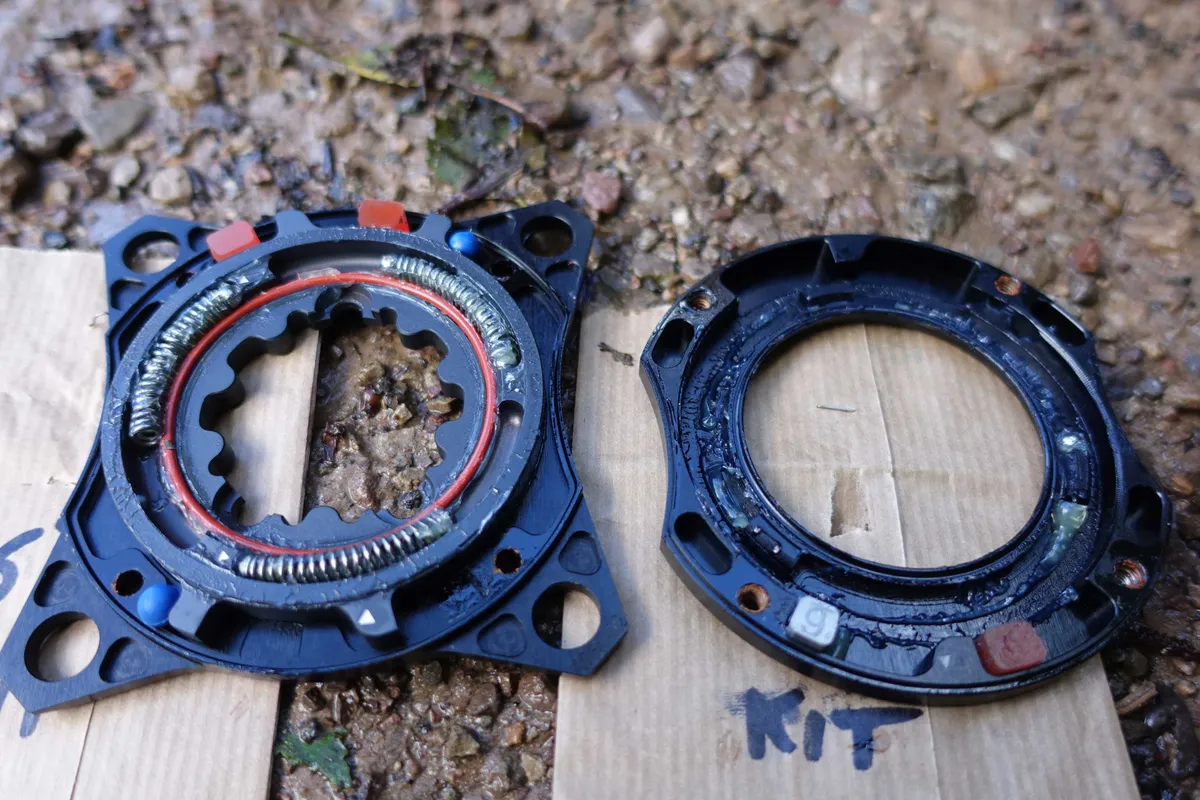Once a niche topic in mountain biking, pedal kickback is now getting plenty of attention. Bike manufacturers are facing questions from buyers, World Cup racers are seeking to minimise it and MTB enthusiasts want to understand the impact on their riding.
There has been a surge in the number of interesting products on the market that promise to reduce pedal kickback, such as the amazing Ochain spider, Rimpact chain damper, E*Thirteen Sidekick hub and, most recently, DT Swiss' DEG DF hub kit.
Let's discuss what pedal kickback is, why it could be a negative for you, and then dive into the solutions that promise to combat pedal kickback, to help you decide whether you should be paying for products designed to reduce its effects.
What is pedal kickback and why should you care about it?

Most, but not all, rear-suspension designs on mountain bikes have some level of pedal kickback.
Pedal kickback can both unsettle you when you're trying to stand on the pedals and impede the suspension’s movement, and as such is regarded as a negative attribute of suspension design.
However, it exists largely because it’s an offshoot of making a bike pedal more efficiently.
Pedal kickback is caused when the suspension compresses, because the distance between the rear wheel axle and the chainring increases. This puts the upper part of the chain under tension and, because it can’t stretch, this can cause the cranks to rotate backwards or ‘kickback’.
If you resist this kickback, you will be putting torque into the rear wheel, resisting the suspension’s movement and making it feel as if the suspension has stiffened suddenly. Therefore, pedal kickback can feel unsettling because the suspension movement can move your feet and make the suspension feel harsh, increasing fatigue, reducing feel and compromising traction.
Which should an engineer prioritise, though? Suspension performance or creating a bike that pedals well? Or is it all about compromise?
The reason so many designs have pedal kickback is not an accident: most have some level of anti-squat built in.
Anti-squat is designed to counteract the suspension’s propensity to compress or ‘bob’ when you're pedalling, and some designers have used it to provide support when pumping the bike through undulations or loading it through turns.
Even on flat, even ground, the force of pushing on the pedals can cause the suspension to compress. Designing anti-squat into the system enables bike engineers to manage the compression caused by the force of the chain tensioning, caused by pedalling.
The level of anti-squat (and the resulting pedal kickback) in a frame’s design is caused by the distance between the suspension’s main pivot and the path of the chain. The closer the pivot and the chain’s path, the less pedal kickback, and the less anti-squat the suspension system will have.
Because of this, the size of the chainring and which gear you’re in on the cassette affect the anti-squat and pedal kickback.
Pedal kickback can cause your feet to feel jerked or kicked when the suspension is moving. The greater issue for some riders and racers is the stiffening-up of the suspension during compression can reduce its efficiency to cope with absorbing impacts and potentially reduce grip.
For bikes that are focused on pedalling efficiently, such as cross-country bikes, anti-squat (and therefore pedal kickback) tends to be greater.
On bikes that are focused on suspension performance at the expense of pedalling efficiency (such as downhill bikes), designers usually prefer to have lower anti-squat numbers and less pedal kickback.
How can pedal kickback be reduced?

Assuming bike designers want some degree of anti-squat to help the bike’s pedalling efficiency, riders are left with the problem of managing pedal kickback induced by these designs.
A number of component manufacturers don’t think you need to have suffer a compromise and have developed their own unique solutions to combat pedal kickback.
Italian manufacturer Ochain (recently purchased by SRAM) was one of the first to the punch, offering a crank spider that added a degree of movement between the crank and the drivetrain using steel and elastomer springs.
This soon became a common sight on World Cup downhill bikes and companies such as Rimpact followed suit with their own versions. The Rimpact spider works in a similar way to the OChain, using a pair of springs that must be compressed in order to engage the chainring, progressively decoupling your feet from the bike’s drivetrain.
But this isn't the only way to attempt to insulate the rider from the effects of pedal kickback.

It can be done with the rear hub too, requiring more intricate engineering. e*thirteen released its Sidekick hub, which was seen as early as May 2024 when Ronan Dunne used it on his Redbull Hardline Dyfi-winning bike. A secondary freehub mechanism disengages the freehub when coasting, and an adjustable engagement 'deadband' enables the rider to choose how many degrees of movement are required before re-engaging.

DT Swiss has recently followed suit with its own kickback-reducing kit called the Degrees Of Freedom (DF), which is compatible with its DEG hubs. It seems to work in a similar way to the e*thirteen Sidekick hub from what we can see.
Like the moving crank spiders, the hubs are intended to isolate the rider from suspension-induced pedal kickback. But whereas the spiders are sprung, enabling the crank to move independently of the chainring, the hubs are designed to enable the wheel to rotate a small amount before engaging the freehub.
Both systems enable the rider to pedal the bike, but they will make pedalling feel slightly different because there is usually a small delay between the rider’s pressure on the pedals and the pick-up of the rear hub.
Which suspension designs suffer from pedal kickback?

Most suspension designs suffer from pedal kickback due to the anti-squat designed into them. These include single pivots, four-bar Horst-link style systems, Virtual Pivot Point swing-link designs, six-bar and even high-pivot suspension systems.

High-pivot suspension designs use an idler to route the chain closer to the main pivot, to manage pedal kickback and anti-squat.
Early high-pivot bikes from Balfa and the carbon fibre Arbr Saker had an idler that was concentric with the bike’s pivot. This means high-pivot bikes now have a reputation for not having pedal kickback, whereas in actuality, most modern high-pivot bikes have idlers placed away from the main pivot to add some degree of anti-squat, therefore resulting in some pedal kickback.
This is why you still see many World Cup downhillers using pedal-kickback reduction devices, even if they ride frames that use a high pivot and an idler.

Unified Rear Triangle (URT) suspension designs and bikes with a concentric pivot have negligible anti-squat and negligible pedal kickback, although they are compromised in other ways because of this: URT bikes have some strange-feeling handling characteristics, and bikes with concentric pivots suffer from pedal bob.
The future of pedal kickback

Anti-squat is important for a bike’s performance, so it’s likely that most suspension designs will continue to induce a level of pedal kickback.
Products that mitigate the effects of pedal kickback have become more commonplace and more numerous, and with manufacturing titans such as SRAM and DT Swiss getting in on the action, it’s likely we will see these products on more bikes in years to come.
Alternatively, electronic damping controls such as Fox Live Valve and SRAM Flight Attendant could increase damping while pedalling or pumping in order to mitigate the suspension’s propensity to bob.
This could offer designers the opportunity to reduce anti-squat significantly, reducing pedal kickback and controlling the resulting pedal bob with instantaneous damping control instead. We’ll report on any developments here on BikeRadar.



